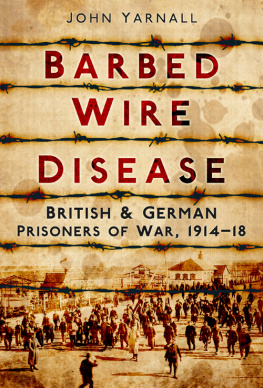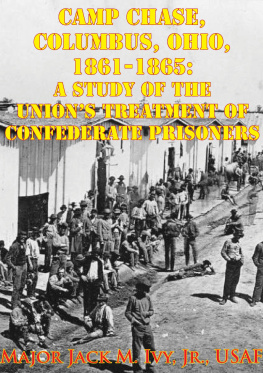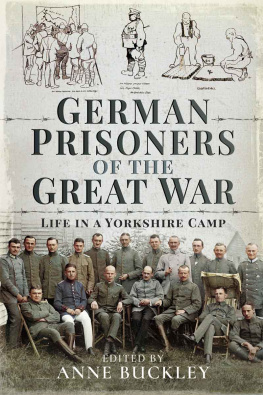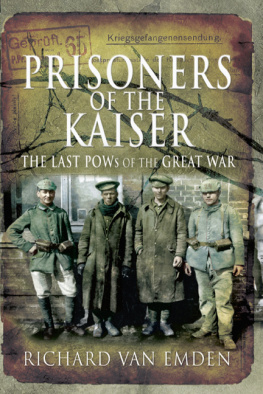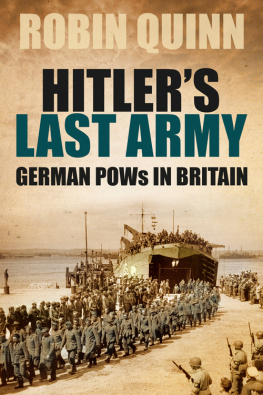BARBED WIRE DISEASE
BARBED WIRE DISEASE
BRITISH & GERMAN PRISONERS OF WAR, 191419
JOHN YARNALL
To Grace
Cover illustration: German prisoners in a French prison camp. French Pictorial Service, 19171919 (National Archives via pingnews)
First published 2011 by Spellmount, an imprint of
The History Press
The Mill, Brimscombe Port
Stroud, Gloucestershire, GL 5 2 QG
www.thehistorypress.co.uk
This ebook edition first published in 2011
All rights reserved
John Yarnall, 2011
The right of John Yarnall, to be identified as the Author of this work has been asserted in accordance with the Copyrights, Designs and Patents Act 1988.
This ebook is copyright material and must not be copied, reproduced, transferred, distributed, leased, licensed or publicly performed or used in any way except as specifically permitted in writing by the publishers, as allowed under the terms and conditions under which it was purchased or as strictly permitted by applicable copyright law. Any unauthorised distribution or use of this text may be a direct infringement of the authors and publishers rights, and those responsible may be liable in law accordingly.
EPUB ISBN 978 0 7524 7262 1
MOBI ISBN 978 0 7524 7261 4
Original typesetting by The History Press
CONTENTS
PREFACE
The number of prisoners taken during the Great War was vast. By 1918, the total number of prisoners held by the belligerents exceeded 6.5 million. The majority of these were held by Germany and Austria-Hungary, 3.4 million, and Russia, 2.25 million. France held 350,000 and Britain 328,000. The remainder were scattered around the other belligerents. Of the 328,000 prisoners held by Britain, about half were located in camps in the United Kingdom and the remainder in British run camps in France and elsewhere. About 185,000 British prisoners were held by Germany.1
This study concentrates on British and German prisoners taken on the Western Front, where alleged neglect and ill-treatment became the subject of major propaganda campaigns in both countries. It looks at day-to-day problems as they unfolded and at the more major disputes which were to arise, drawing heavily on published and unpublished official documents, as well as contemporary newspapers and other accounts. This book also identifies many examples of hardship and ill-treatment and some of deliberate physical abuse. But the full story of prisoners in the Great War goes beyond a simple narrative of their experiences and the conditions they faced. That is not to say that these issues are not important, because from the point of view of individual prisoners they are, after all, what really mattered. But such conditions need to be seen against the wider background of the diplomatic, political and military objectives which gave rise to them. This study sets the wider context. Incidents such as the suffering caused to Allied prisoners by the mismanagement of typhus outbreaks in some of the German camps in the early part of the war, or the shooting of unarmed interned civilians during a food riot at a camp in the Isle of Man, stand out as particular examples of unacceptable treatment. By contrast, the treatment by both sides of many prisoners, and of officers especially, reached standards which would be more than acceptable today. The political and diplomatic story is similarly one of both successes and failures. Military considerations overrode diplomatic preferences on numerous occasions, especially in relation to exchanges perhaps most notably in the case of the British policy to intern rather than exchange enemy civilians at the insistence of the War Office and also in relation to the decision by both sides to employ prisoners in the war zone. But the predominant diplomatic theme to emerge is the willingness of both sides to invest heavily in the cause of improving the lot of prisoners and ensuring their humane treatment. Their progressive approach achieved much in securing practical improvements in conditions, including agreement on limited prisoner exchanges and internments in neutral countries. Their final achievement in drafting comprehensive agreements to plug the gaps exposed in the workings of the recently agreed Hague and Geneva conventions represented a real step forward. The process of achieving this success forms a major focus of the study. Sadly, much of the work was completed too late to have any great practical impact during the war itself. The lessons learnt were, however, invaluable to those whose task it was to update the conventions at Geneva in 1929, in advance of the Second World War.
INTRODUCTION
The First World War was the first major war in history to be conducted on the basis of internationally agreed standards for the treatment of prisoners and wounded taken on the battlefield, marking a milestone in the evolution of the treatment of prisoners through the ages. In the earliest times prisoners of war (POWs) had been simply put to death or, if they were more fortunate, enslaved for their labour value. In medieval times, they had been sent to the galleys, not just for the duration but often to stay there beyond the end of the conflict in which they were engaged. Later, it became the practice for prisoners to be exchanged or ransomed by their captors. By the seventeenth century, POWs began to be regarded as prisoners of the state rather than the property of their individual captors. This gave rise to the first international agreements on prisoners. A treaty between Spain and England in 1630 provided for the speedy return of prisoners following the end of hostilities, and a treaty between the USA and Prussia in 1785 sowed the first seeds of regulation on the way in which prisoners should be treated. State involvement also gave rise to the development in the seventeenth and eighteenth centuries of cartels, or agreements for the exchange of prisoners based on elaborate tariffs. Such cartels usually included the condition that those exchanged would take no further part in hostilities. These arrangements themselves eventually died out, however, to be replaced by the now more familiar practice of internment for the duration, followed by repatriation.1
Despite these improvements, prisoners continued to be treated harshly into the nineteenth century. But during the nineteenth century, as weapons became more destructive and casualties increased, pressure grew to make war more humane. In 1863, the International Committee of the Red Cross was established at Geneva after the Battle of Solferino (1859), where some 40,000 sick and wounded had been left on the battlefield with no mechanism in place for their care. At a diplomatic conference called by the Red Cross in 1864, the First Geneva Convention was adopted by sixteen states.2 This established the principles that relief should be given to the wounded on the battlefield without any distinction as to nationality, and that medical personnel and their units (to be identified by the Red Cross symbol) were to be treated as neutral and inviolable. The convention was expanded and updated in 1906.3 The Hague Peace conferences of 1899 and 1907 continued the process of developing international humanitarian law by applying the Geneva Convention to sea warfare4 and by agreeing conventions (the Hague conventions) governing the conduct of war on land.5 Amongst other things, the Hague conventions set out detailed rules on the treatment of prisoners. At the time of the First World War, the 1907 Hague Convention and the 1906 Geneva Convention together provided a comprehensive set of rules available to all belligerents. Both Britain and Germany had ratified the conventions and had it as declared policy to comply with their provisions. But even states that had not signed up to the conventions now had before them a set of rules representing contemporary thinking on how POWs and the wounded should be treated.

